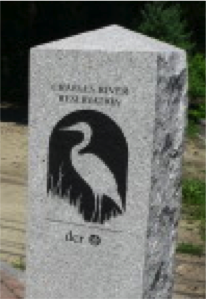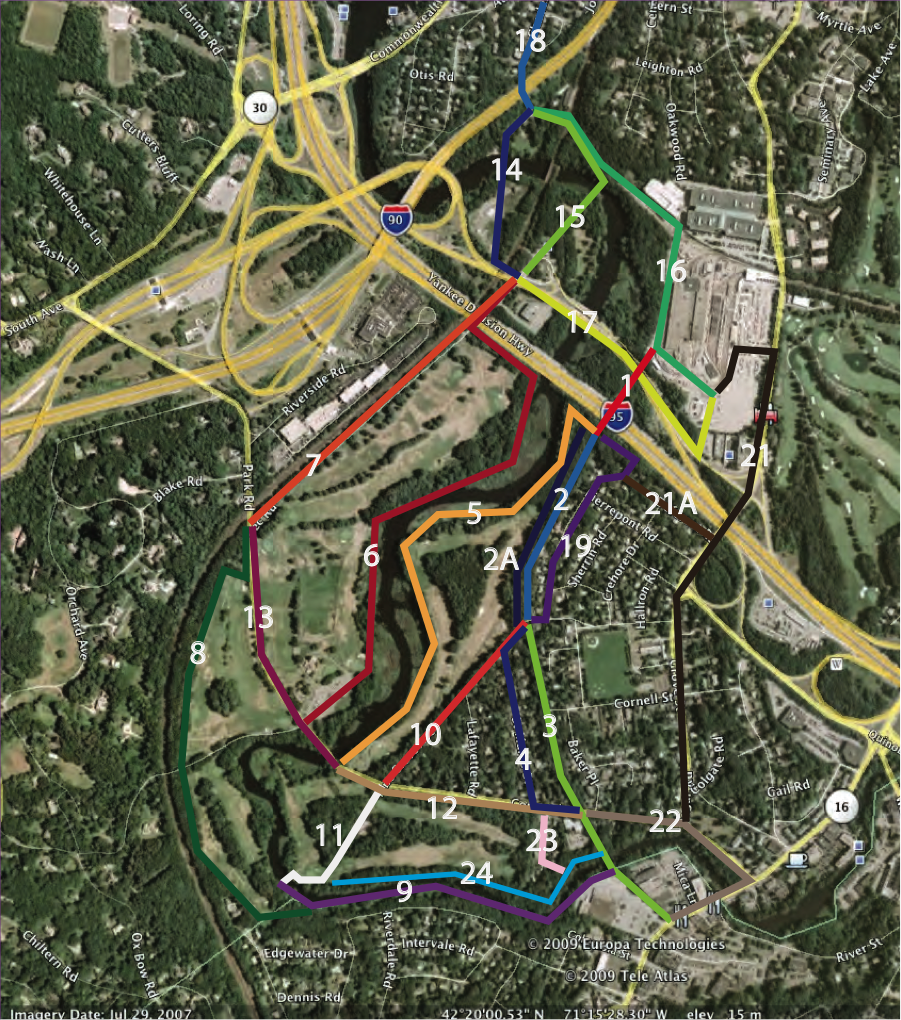- Home
- Our Neighborhood
- Recreation Trails in Lower Falls
- History of the Pathway
History of the Pathway
Published in the Lowdown October 2016
The concept of a bike/footpath through Newton Lower Falls has been on the table since 1969 comprehensive Recreation/Open Space Plan by the Newton Planning Department, authorized the publication in 1975 by the Newton Conservation Commission Charles River Pathway. The following objectives of this pathway were listed:
1. To have a continuous footpath along the Charles River.
2. To conserve the banks of the Charles in as natural a setting as possible.
3. To add to outdoor recreational and educational opportunities available to the City.
This proposal is part of the Charles River Bike Path (https://en.wikipedia.org/wiki/Charles_River_Bike_Path) and the Blue Heron Trail in Newton (http://www.newtonconservators.org/longwalkcharlesnorth3.htm). Both are segments of a larger system envisioned by the Metropolitan Park Commission in a report from 1892 by the landscape architect Charles Eliot “consisting of the banks of the Charles, Neponset and Mystic Rivers, the Blue Hills, the Middlesex Fells, and Lynn, Nahant, Winthrop, Quincy, and Nantasket beaches. This is how the report described the Newton section of the Charles river – “Within ten miles of Boston, there is a stretch of river scenery that cannot be surpassed in the United States.”

The Massachusetts Department of Conservation and Recreation (DCR) proposal for the section of the Blue Heron pathway through Lower Falls used the abandoned railroad line beginning at the bridge from Wellesley Hills through the woodland behind St Mary’s Street, across Pine Grove, continuing along the edge of the Leo J. Martin golf course parallel to Clearwater St, across Rt. 128/I95 and its access road using two bridges to Riverside (see segments 1.2.3 on the map).
LFIA Involvement
In 2009 there was a renewed interest in the Lower Falls pathway by the Massachusetts Department of Conservation and Recreation, which met opposition by abutters of the rail trail who filed a lawsuit against DCR. The controversy tore at the fabric of the Lower Falls community. In response the LFIA decided to not take any position for or against the trail, but rather to act as an educational resource for the community. The LFIA created a group to look at alternatives to the rail trail. The group defined 24 path segments that could be variably linked to get from the Wellesley Bridge to the LaSalle boathouse. (link to Preliminary Report of the Alternative Routes Study Group, Alternatives Presentation).

An engineering firm was commissioned by a local foundation to look at the costs of 3 of the more desirable routes (segments 5, 6, 13+7). (CRNF bike trail alternatives).
In 2010 the MBTA-initiated discussion over development of the Riverside T Station created a new incentive to look at alternative pathways. A simple link from Lower Falls to Riverside using segments 19 and 1 was promoted as safer pedestrian route to Riverside than negotiating the two new roundabouts. The segment could be linked to others to complete the pathway from Wellesley to LaSalle boathouse. (See Path Proposal to Riverside, and Bridges Path to Riverside). This proposal drew the interest of the larger Newton community and our local legislators. Consequently, as part of the mitigation package offered by the developer, funds were set aside for projects like trails.
Current Status
In 2016 the Massachusetts Supreme Judicial Courts ruled on the appeal from the Massachusetts Land Court by the plaintiffs, that the decommissioning of a trail line is a federal issue.
This finding has injected new life into discussions of the trail through Lower Falls becoming a reality. There are stakeholders* who would like to see this happen, including the DRC, the Wellesley Trails Committee, Bike Newton, and Newton Conservators. In anticipation of further discussion, the LFIA encourages the members of the LFIA to learn about the pathway. Immediately following the LFIA community meeting on October 23rd, there will be a group walk along portions of the DCR land to help familiarize people with the content of these discussions.
- Bike Newton, a 501c3 organization, aims to promote bicycling as a viable method of transportation in Newton, Massachusetts. Bicycling should be safe and convenient for all, org
- NRC Wellesley Trails Committee http://www.wellesleyma.gov/pages/wellesleyma_trails/index
- Newton Conservators – Newton Conservators Inc. promotes the protection and preservation of natural areas, including parks, park lands, playgrounds, forests and streams, which are open or may be converted to open spaces for the enjoyment and benefit of the people of Newton for scientific study, education, and recreation. It further aims to disseminate information about these and other environmental matters. http://www.newtonconservators.org/aboutus.htm
- DCR : Department of Conservation and Recreation http://www.mass.gov/eea/agencies/dcr/massparks/recreational-activities/biking-paths-and-trails.htm
Past Events and Historical Documents
- 2020 Sept 22
In 2020 the DCR conducted a feasibility study the Lower Falls Trail options - 2020 March 19
LFIA held a virtual Trails Update meeting to let neighbors know about two DCR RFPs (Request for Proposals) and other trail developments associated with the Riverside Development and the Riverside Greenway in Auburndale. View the slide show and recording of the March 19th, 2020 meeting. Download the RFPs for the Lower Falls Trails and the Quinobequin Trail 100% Design studies.
- 2018 April
Trails Update, Published in the Lowdown
-
2018 January 24
The Riverside Greenway Working Group presented an overview of their work during a meeting at the Newton Main Library on January 24th 2018. View the slide show or a video of the event with presentations by Emily Norton of the Charles River Watershed Association, Dan Driscoll of Mass DCR and Herb Nolan of the Solomon Foundation and the Riverside Greenway Working Group, including the Q&A filmed by Ted Kuklinski of the Newton Conservators\
-
2017 April 9
LFIA Spring Meeting. The LFIA decided not to be a co-applicant to the DCR-Recreational Trails Program for a grant "Two
Bridges Trail from Newton Lower Falls to Riverside." LFIA withdraws Grant Application. Grant was awarded to Bike Newton. (LFIA mistakenly included in announcement).
-
2016 October
History of the Pathway, Published in the Lowdown
- 2012 - 2013
The Accelerated Bridge Program for Massachusetts studied three Charles River pedestrian bridges in our area for rehabilitation and restoration. This program was established under Governor Deval Patrick 2007-2015, thanks to Mass DOT and DCR.
- The Trestle Bridge was restored after persistent advocacy from DCR, Newton Conservators, League of Women Voters, the Newton Bike and Pedestrian Task Force, Bike Newton, Town of Wellesley, Lower Falls neighbors and Sate Representative Kay Khan. The Trestle Bridge connects a piece of the old rail trail from Concord Street crosses the river to Wellesley Lower Falls. Construction began on 12/2010, with a ribbon cutting on the bridge in 2012.
- The Pony Truss Bridge located in Riverside Park (the historic location of Riverside Recreation Area, referred to as 'The Rec') was rebuilt and opened in 2013.
- The Lasell Boat House / Recreation Road Bridge in Auburndale will be fully replaced in the Spring of 2022, thanks to to the amazing work of Riverside Greenway Committee who are working tirelessly with DCR, MassDOT, The Solomon Foundation, Mark Development, the city, conservation and many elected officials.
- 2009
The LFIA Alternative Trails Group assessed trail segments as alternatives to the rail trail. Download the study
